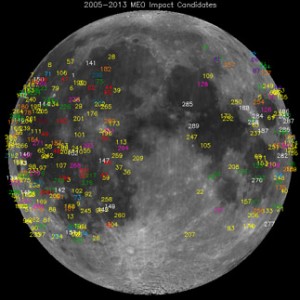UH-Hilo Student Taking Part in Lunar Probe Mission
***Updated at 11:03 a.m. Thursday to correct day of launch.***
A student at the University of Hawaii at Hilo will take part in this week’s launch of NASA’s latest moon probe.
The Lunar Atmosphere and Dust Environment Explorer will be launched Friday, Sept. 6, aboard a Minotaur V rocket from NASA’s Wallops Flight Facility on Wallops Island, Va.
Krystal Schlechter, a sophomore, spent the past summer as an intern with the Hilo-based Pacific International Space Center for Exploration Systems.
Schlechter was taking part in the Lunar Impact Observing Program, in which student and community volunteers use small telescopes to observe faint flashes produced by meteoroid impacts on the unlit portions of the moon.
The video they recorded was processed to identify the impacts and then sent to NASA’s global impact database.

This NASA image shows the locations of meteroid flashes detected on the moon over the past eight years.
The data from the program was combined with observations from larger telescopes operated by NASA in Alabama and Georgia.
The information is being collected to analyze conditions on the moon’s surface that would be encountered by astronauts on extended stays.
According to NASA’s Meteroid Environment Office, spacecraft, vehicles, habitats, and “space” suits must all be designed to withstand the stresses posed by the harsh lunar environment over that period of time.
“Meteoroids, and the ejecta produced when they create impact craters, are part of this environment,” NASA says.
Because the moon has no atmosphere to slow them, meteoroids are traveling between 45,000 mph and 160,000 mph when they strike the lunar surface.
“At such speeds, even a small meteoroid has incredible energy,” the MEO said, adding that one weighing as little as 10 pounds can create a crater more than 30 feet across, blasting out more than 82 tons of lunar rock and soil.
NASA said current models indicate that the moon is struck by meteoroids weighing more than two pounds more than 200 times each year.
Schlechter also presented her work to the NASA Lunar Forum during a virtual online conference this past summer, a UH-Hilo spokeswoman said in a statement issued today.

Krystal Schlechter is shown taking part in an online forum in this screenshot from the PISCES Facebook page.
She and her mentor, John Hamilton, tests logistic manager for PISCES, were invited to be part of the official launch effort and join the public outreach activities at the Wallops Island Visitor Center, the spokeswoman said.
The 850-pound LADEE spacecraft will examine the density and variability of dust particles in the lunar atmosphere.
The probe will take about 2½ months to reach the moon and get into its orbit before the 100-day-long scientific mission begins.
Coverage of the launch will begin on NASA Television beginning at 3:30 p.m. Friday, with the launch scheduled for 5:27 p.m.















